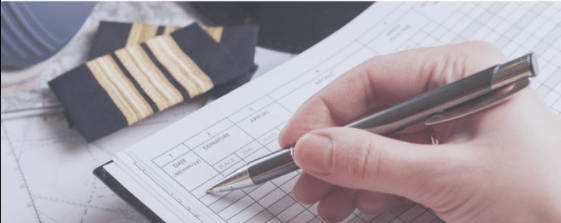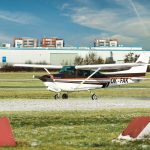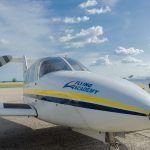
Medical exam assistance for students of Flying Academy
Please find below the required Medical Certificate for the student to obtain in order to start training:
PPL – 2 class
NR – 2 class
IR – 1 class
CPL – 1 class
MEP – 1 class for IFR part, 2 class for VFR part
FI/IRI – 1 class
0-ATPL with US experience – 1 class
0-ATPL with TB in US – 1 class
0-ATPL – 1 class
ATPL theory – 2 class
Students at Flying Academy can schedule themselves for the medical.
Flying Academy will be happy to help if assistance is needed.
First class medical certificate
A first class medical certificate is required for all pilots involved in commercial aviation. This certificate has the most restrictive medical standards. The holder of a medical certificate must be mentally and physically fit to safely exercise the privileges of the applicable license.
If you are not a holder of the first class medical certificate, we will be glad to help you arrange your examination in an authorized Aeromedical Centre.
Aeromedical examination
Initial examinations for a first class medical certificate shall be carried out at an AMC (Aeromedical Centre). The revalidation and renewal examinations may be delegated to an AMC or an AME (Aeromedical Examiner).
Aeromedical Centres (AME) authorized to issue first class medical certificates in the Czech Republic are “ULZ” in Prague.
Acceptance of medical certificate
Certificate issued by any EASA member state is accepted without formality by other EASA member state.
First class medical certificate requirements
The medical requirements for a PART-FCL pilot’s license are contained in PART-MED (Medical).
The Joint Aviation Requirements (PART-FCL) is a series of regulations covering all of aviation that have been implemented in the EASA European aviation safety agency.
Medical History – these are the questions about past illnesses declared on your application form. You will be asked about them by the examining doctor and if a history exists, it is recommended to bring reports from your physician. Simple appendicitis or a broken arm are not regarded as major illnesses.
Eyesight – the examination form and the exact requirements are listed in PART-FCL Class 1 Visual Standards:
- Distance Vision – Your visual acuity (measured by your ability to see-in this case, lines of letters on a chart at 6 meters) must be at least 6/9 in each eye separately and 6/6 using both eyes together, with or without glasses or contact lenses (correction). If you need correction, the refractive error (the amount of correction) must not exceed +5.00 diopters of long sight or -6.00 diopters of short sight. This is in the most ametropic meridian (taking into account any astigmatism). Astigmatism must not exceed 2.00 diopters. The difference in correction between each eye (anisometropia) must not be more than 2.00 diopters. Your optometrist will be able to further explain these terms.
- Near Vision – On the standard near vision eye chart you must be able to read the N5 print between 30 and 50 cm and the N14 print at 100 cm, with or without correction.
Contact Lenses – You may wear contact lenses as a professional pilot, but they must be monofocal, nontinted and for distant vision (not to correct near vision). Any contact lenses should be brought to the examination. - Eye surgery – Applicants who have undergone eye surgery may be assessed as fit subject to satisfactory ophthalmic evaluation (see PART-MED.B.070 Visual System Subpart (f)).
- Color Vision – You will be tested for normal color vision with Ishihara Test Plates (a series of numbers or shapes outlined by different colored dots, easily seen by someone with normal color vision). If you fail these you will need to pass an approved lantern test (a series of colored lights that you must identify correctly) in order to gain a PART-FCL Class 1 certificate.
- Eye Function – You must have normal fields of vision. You must not suffer from double vision. Any degree of heterophoria (eye muscle imbalance) in excess of: 8Δ exo, 10Δ eso or 2Δ hyperphoria – measured at 6 m or 12Δ exo, 8Δ eso or 1Δ hyperphoria – measured at 33 cm will require further evaluation by an eye specialist. There must be no acute or chronic disease in either eye or surrounding structures.
If you are in any doubt you should take a copy of the standards to an optician who will be able to interpret them. This will allow you to have an initial eye test before going to an AMC.
Physical Examination – a general check that everything is functioning correctly. It will cover lungs, heart, blood pressure, stomach, limbs and nervous system.
Ears – The basic hearing test used throughout PART-MED is the ability to hear conversational speech when tested with each ear at a distance of 2 meters from and with your back turned towards the medical examiner (PART-MED.B.080 Otorhino-laryngology Subpart (b) and (c)). This test is done at every medical examination for both professional and private pilots.
For professional pilots, and private pilots with an instrument rating, a further test called an audiogram is required. The audiogram is a test where you signify that you have heard sounds at different frequencies. Perfect hearing is measured as nil loss of hearing (0 decibel – 0 dB) at that particular frequency. Decreased hearing is shown as a decibel loss (10, 20, 30, 40 decibels) at a particular frequency. The required hearing levels and the maximum allowable losses are listed below:
- Frequency – Allowable loss
500 Hz – 35 dB
1000 Hz – 35 dB
2000 Hz – 35 dB
3000 Hz – 50 dB
If you can hear a normal voice in each ear separately at 2 meters, you should not have a problem.
There may be some loss of hearing as a pilot’s career progresses (often due to noise induced hearing loss). If the audiogram figures reach a level 5 dB less than the renewal figures above, then an annual audiogram is required.
Electrocardiogram – (ECG) – this measures the electrical impulses passing through your heart. It can show disorders of the heart rhythm or of the conduction of the impulses. Sometimes it can show a lack of blood supplying the heart muscle. In the unlikely event of these changes showing on your ECG, further tests with a report from a cardiologist will have to be sought.
Lung Function Test (spirometry) – this tests your ability to breathe deeply and to expel air from your lungs.
Haemoglobin blood test – this is a finger prick blood test which measures the oxygen carrying capacity of the blood. Low hemoglobin is called anemia and will need further investigation.
Cholesterol blood test – the same finger prick as above. There is no disqualifying level, but the possible health risks of high cholesterol will be explained by the doctor at the time of your examination.
Chest X-ray – this investigation is not required for PART-FCL Class 1, but may be required when indicated on clinical or epidemiological grounds.
Urine test – mainly looking for sugar (diabetes), protein or blood.
For detailed description of the Medical Requirements for Flight Crew Licensing please see PART-MED.
For how long does EASA 1 Class medical is valid?
The Period of Validity of EASA medical certificate is determined by:
- Applicant’s age on the date of the examination.
17-39 years – valid for 12 months
40-59 years – valid for 6-12 months (dependent on type of flying undertaken)
60 plus years – valid for 6 months - The type of flying undertaken (only applicable if aged 40-59). For pilots aged between 40 and 59 on the date of their examination the validity varies according to the type of flying undertaken.
Single pilot commercial air transport operations carrying passengers – valid 6 months
Other commercial operations, ie multi-pilot, flying instructor – valid 1 year - Whether the examination is a Revalidation or Renewal.
a. Revalidation means an examination undertaken while you hold a current medical certificate. You can schedule a revalidation medical on the date of expiry or up to 45 days in advance of that date. The new expiry date is calculated by adding the relevant number of months of the new validity period to the expiry date on your current certificate.
b. Renewal means you take a reexamination if you have let your certificate expire. The new expiry date is calculated by adding the relevant number of months of the new validity period to the date of examination. For an examination undertaken very early (more than 45 days before the current certificate is due to expire) the renewal rules apply.
Second class medical certificate
A second class medical certificate is required only for General Aviation pilots – those that fly as a hobby. Since the holder is not involved in commercial activities, the certificate is not as restrictive; still, the holder of the medical certificate must be mentally and physically fit to exercise safely the privileges of the applicable license.
If you are not a holder of the second class medical certificate, we will be glad to help you arrange your examination in an authorized Aeromedical Centre.
It is at the examiners discretion if the psychological test will be conducted for second class medical certificate. Still it is required only if there is serious suspicion of alcoholism, suicide attempt, depression or other similar factors.
Trainees applying for a flight fitness examination should approach their appointment with appropriate responsibility. In view of the complex nature of examination we recommend that the applicants observe a healthy lifestyle over the long-term and have only a light dinner the evening before their examination. They should also refrain from consuming alcohol, avoid social events and partying till the early morning hours prior to their appointment as the applicants should get enough sleep and rest when presenting themselves for their examination. The initial examination undertaken by military and civil professionals also includes a detail psychological assessment.
Our staff can schedule you for the medical check-up which will be performed at The Institute of Aviation Medicine in Prague.
Medical Examination in Prague
When you arrive to the Institute of Aviation Medicine, please do not forget to mention that you are from Flying Academy. It is also important not to eat in the morning before the exam as you should arrive on empty stomach.
Do not forget to bring the money with you, as the fee needs to be paid in cash.
Medical Examination in Vienna
The exam will take place until approximately 4-5 PM and you should go there on an empty stomach, as they will be taking some blood samples.
Do not forget to bring the money with you, as the fee needs to be paid in cash.
Before going, you should fill in this form and bring it with you:
wiener-privatklinik.com/static/media/uploads/pdf_downloads/ac_application_form.pdf
If you have some questions regarding filling up this form, feel free to ask us.
Please do not forget to remind them that your pilot license will be issued in the Czech Republic and they need to put it on the medical.
The address of the clinic is:
Wiener Privatklinik
Lazaretgasse 25
1st floor
How much does the medical examination cost?
Prague
- Class 1 – 490,- EUR
- Class 2 – 100,- EUR
Vienna
- Class 1 – 815,- EUR
- Class 2 – 350,- EUR
If you need any information about how the exam will look like, please contact Office in Prague [email protected]. (phone: +420 732 763 678) or in Brno (phone: +420 778 477 728) or write us an email: [email protected].






